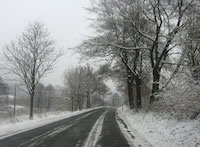
Winter, however, is the one season that can show us just how fragile we are. When a minor vehicle difficulty forces us to face the brutality of cold temperatures, what might have been a relatively simple situation can turn life-threatening before you even realize you’re in danger.
Traveling safely in winter comes down to three factors: ensuring your vehicle is in proper working order, knowing how to face road hazards and wintery conditions, and being prepared in the event of an incident or vehicle failure.
Ensuring your vehicle is in proper working order means checking things like tire pressure and condition, fuel level, brakes, battery, antifreeze, and other critical components before venturing onto the roadway. Winter isn’t just harsh on us; it can wreak havoc with mechanical systems and components. Staying on top of the condition of these components can keep you out of a dangerous situation before it has the chance to develop in the first place.
Road hazards and wintery conditions are an additional challenge and far too often we mistake technological augmentation for improvements in our own abilities behind the wheel. Ice does not care that you have four-wheel drive or all-wheel drive. While these systems might make it easier to get moving in the snow, they have absolutely noimpact on your ability to stop. Countless incidents occur, however, when drivers falsely believe that their vehicle has somehow developed the magical ability to stop on ice.
In addition, knowing how to use anti-lock brakes or keep non-anti-lock brakes from locking up under hard stopping conditions is critical, as is the knowledge of what to do in the event of a skid or loss of traction.
Finally, while most of us will never have to face the horror of being stranded, plenty more live in areas where a loss of vehicle power poses a serious threat. Keeping a small but ample supply of survival supplies in an easily-accessed area of the vehicle will ensure that if you have to spend time waiting for help to arrive, that you can do so safely, warmly, and without the threat of going hungry. A kit that includes blankets and hats, high-energy foods, a flashlight and batteries, flares, and a few other key items should be maintained at all times, but especially in the winter.
A little bit of prevention can go a long way toward keeping you safe during your winter travels. For more tips and ideas for your roadside emergency kit, take a look at this great post from the National Safety Council.
